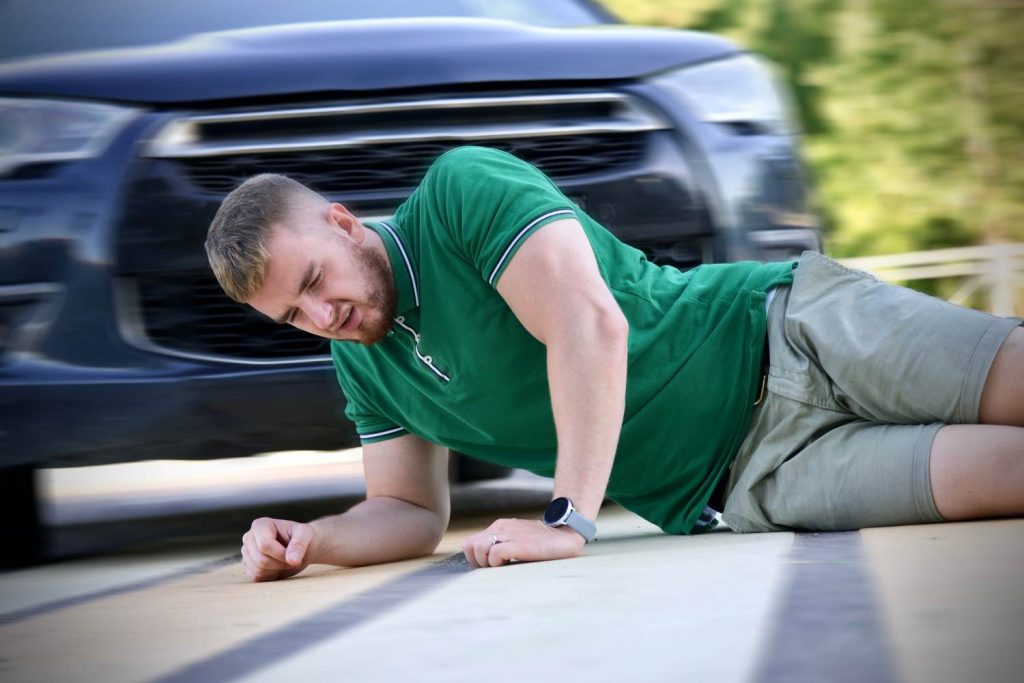Pedestrian Injury Accident FAQs
Top-Rated Illinois Car Accident Lawyers Answer Frequently Asked Questions about Car vs. Pedestrian Crashes

Pedestrian accidents are among the most devastating types of personal injury cases. With no protection against the impact of a vehicle, pedestrians are at serious risk of life-changing injuries or even death in the event of a collision. In Illinois, pedestrians have legal rights, and drivers are obligated to exercise caution around those walking near or across roadways. However, determining liability and pursuing compensation can be a complex process.
At John J. Malm & Associates, we represent pedestrians who have been injured in accidents throughout Illinois. Below, we answer the most frequently asked questions about pedestrian accident claims, the legal process, and what you can do if you or a loved one has been involved in such an accident.
“Pedestrian accidents often result in severe injuries due to the vulnerability of those walking near roadways. Our job is to protect pedestrians’ rights and ensure that negligent drivers are held accountable. We work hard to pursue the compensation our clients need for medical expenses, lost wages, and pain and suffering.” — John J. Malm, Illinois pedestrian injury attorney
1. What Should I Do After Being Hit by a Vehicle as a Pedestrian?
Being hit by a vehicle as a pedestrian can be terrifying, and the actions you take immediately after the accident can significantly impact your ability to recover compensation. Here’s what to do if you’re involved in a pedestrian accident:
- Seek Immediate Medical Attention: Even if your injuries don’t seem severe at first, seek medical attention as soon as possible. Some injuries may not be immediately apparent but can worsen over time, such as head trauma or internal injuries.
- Call the Police: Report the accident to law enforcement. Having a police report is critical for documenting the incident, identifying the driver involved, and preserving evidence.
- Get Contact Information: Obtain the name, contact information, driver’s license number, and insurance information of the driver who hit you. If there were witnesses, get their contact information as well.
- Document the Scene: If you’re able to do so, take pictures of the scene, the vehicle involved, your injuries, and any other factors that may have contributed to the accident, such as poor lighting or a malfunctioning traffic signal.
- Contact an Attorney: Pedestrian accidents can lead to complicated legal and insurance claims. Contact an experienced Illinois pedestrian accident attorney to help protect your rights and guide you through the legal process.
2. What Are Common Causes of Pedestrian Accidents in Illinois?
Pedestrian accidents are frequently caused by negligent driving behaviors, dangerous road conditions, or poor visibility. Some of the most common causes include:
- Distracted Driving: Drivers who are texting, talking on the phone, or otherwise distracted are a leading cause of pedestrian accidents. Distracted drivers may fail to see pedestrians crossing the street or walking along the road.
- Speeding: Drivers who exceed the speed limit have less time to react to pedestrians and are more likely to cause severe or fatal injuries in a collision.
- Failure to Yield: Illinois law requires drivers to yield the right-of-way to pedestrians at crosswalks. Failing to do so can lead to devastating accidents.
- Driving Under the Influence: Drivers who are impaired by alcohol or drugs are more likely to hit pedestrians due to their slowed reaction times and impaired judgment.
- Left-Turn Accidents: Many pedestrian accidents occur when a driver is making a left turn and fails to notice a pedestrian crossing the street.
- Poorly Marked Crosswalks or Lack of Sidewalks: In some cases, dangerous road conditions or the lack of designated pedestrian areas can contribute to accidents.
3. Who is Liable in a Pedestrian Accident?
In most pedestrian accident cases, the driver of the vehicle that hit the pedestrian is liable if they were driving negligently. However, determining liability can sometimes be complex, and multiple parties may be responsible, depending on the circumstances.
Common Liable Parties Include:
- The Driver: Drivers have a duty to exercise caution when pedestrians are present, especially at crosswalks and intersections. If the driver was speeding, distracted, impaired, or failed to yield, they are likely to be held liable for the accident.
- The Municipality or Government Entity: If the accident was caused by unsafe road conditions, malfunctioning traffic signals, or poorly designed pedestrian crossings, the government entity responsible for maintaining the roadway may be held liable.
- The Pedestrian: Illinois follows a modified comparative negligence rule, meaning that if the pedestrian is found to be partially at fault for the accident—such as by jaywalking or crossing against the light—their compensation may be reduced by their percentage of fault. If the pedestrian is found to be more than 50% at fault, they may not recover compensation at all.
4. What Are Common Injuries in Pedestrian Accidents?
Because pedestrians have no physical protection from the force of a vehicle, the injuries sustained in pedestrian accidents are often severe or life-threatening. Common injuries include:
- Traumatic Brain Injuries (TBIs): Head injuries are common in pedestrian accidents and can range from concussions to more severe traumatic brain injuries that result in permanent cognitive or physical impairments.
- Spinal Cord Injuries: Spinal cord damage can lead to paralysis or other long-term disabilities.
- Broken Bones: Fractures of the arms, legs, ribs, or pelvis are common in pedestrian accidents, often requiring extensive medical treatment and rehabilitation.
- Internal Injuries: The impact of a vehicle can cause damage to internal organs, leading to life-threatening complications.
- Lacerations and Soft Tissue Injuries: Deep cuts, bruising, and ligament or tendon injuries are common in pedestrian accidents.
- Fatal Injuries: Unfortunately, many pedestrian accidents result in fatalities, especially in high-speed collisions.
5. What Insurance Coverages May Apply to a Pedestrian Accident?
When a pedestrian is injured in an accident, multiple insurance coverages may apply, depending on the circumstances of the accident:
- The Driver’s Auto Insurance: If the driver is at fault, their liability insurance will typically cover the pedestrian’s medical bills, lost wages, and other damages, up to the policy limits.
- Your Own Auto Insurance: If you have uninsured/underinsured motorist (UM/UIM) coverage, it may apply if the driver responsible for the accident doesn’t have sufficient insurance or flees the scene in a hit-and-run accident. UM/UIM coverage can help compensate you for your injuries if the at-fault driver lacks adequate insurance.
- Personal Health Insurance: Your health insurance may cover some of your immediate medical bills following a pedestrian accident, but it’s important to pursue compensation from the at-fault driver or their insurance company for medical expenses not covered by your policy.
- MedPay: If you have medical payments coverage (MedPay) on your own auto insurance policy, it may provide additional coverage for your medical bills, regardless of who was at fault in the accident.
Navigating the various insurance coverages after a pedestrian accident can be complex, so it’s important to work with an experienced car accident attorney who can identify all available sources of compensation.
6. What Compensation Can I Recover After a Pedestrian Accident?
If you’ve been injured in a pedestrian accident, you may be entitled to recover compensation for a variety of losses, including:
- Medical Expenses: This includes all costs associated with your medical treatment, such as hospital bills, surgeries, physical therapy, prescription medications, and any necessary ongoing care.
- Lost Wages: If your injuries prevent you from working, you can seek compensation for lost wages. If your injuries are long-term or permanent, you may also recover compensation for lost future earning capacity.
- Pain and Suffering: Compensation for the physical pain and emotional distress caused by your injuries.
- Disability and Disfigurement: If your injuries result in permanent disability or disfigurement, you may recover additional compensation for the impact on your quality of life.
- Loss of Normal Life: This refers to the loss of enjoyment of everyday activities or hobbies due to your injuries.
- Wrongful Death Damages: If a loved one was killed in a pedestrian accident, surviving family members may be able to pursue a wrongful death claim for compensation to cover funeral expenses, loss of financial support, and the emotional pain of losing a loved one.
7. How Long Do I Have to File a Pedestrian Accident Claim in Illinois?
In Illinois, the statute of limitations for filing a personal injury lawsuit related to a pedestrian accident is generally two years from the date of the accident. This means you must file your claim within two years or risk losing your right to pursue compensation.
If the accident resulted in the death of a loved one, you have two years from the date of death to file a wrongful death claim.
If your claim involves a government entity (such as if the accident occurred due to unsafe road conditions), there may be additional notice requirements and shorter deadlines. It’s crucial to consult with an attorney as soon as possible after the accident to ensure all deadlines are met.
8. Do I Need an Attorney for a Pedestrian Accident Claim?
While you are not required to hire an attorney to file a claim, having an experienced car accident injury attorney can significantly improve your chances of recovering the maximum compensation. Insurance companies may attempt to minimize your injuries, dispute the extent of your damages, or even try to place blame on you to reduce their payout. An attorney can help level the playing field by negotiating with insurance companies and gathering crucial evidence to strengthen your case.
Additionally, personal injury attorneys are experienced in handling insurance liens, such as those filed by health insurance companies, Medicaid, or Medicare, which may impact your final settlement. Resolving these liens is a critical part of maximizing your recovery, as unpaid liens can reduce the amount you ultimately take home from your settlement. Your attorney will work to confront and resolve these liens to ensure you receive the highest possible compensation for your injuries.
If the pedestrian accident involves a child, an attorney is required to handle the case. In Illinois, court approval is typically required to settle a minor’s personal injury claim, and an attorney will be needed to represent the minor’s interests throughout the process. This ensures that the minor’s settlement is fair and that their legal rights are fully protected.
Contact the Top-Rated Illinois Pedestrian Accident Attorneys at John J. Malm & Associates for a Free Consultation
If you or a loved one has been injured in a pedestrian accident in Illinois, contact John J. Malm & Associates for a free consultation. With offices in Naperville and St. Charles, we are ready to help you navigate your legal options and fight for the compensation you need. Contact our Illinois car crash attorneys today, and let us protect your rights.









